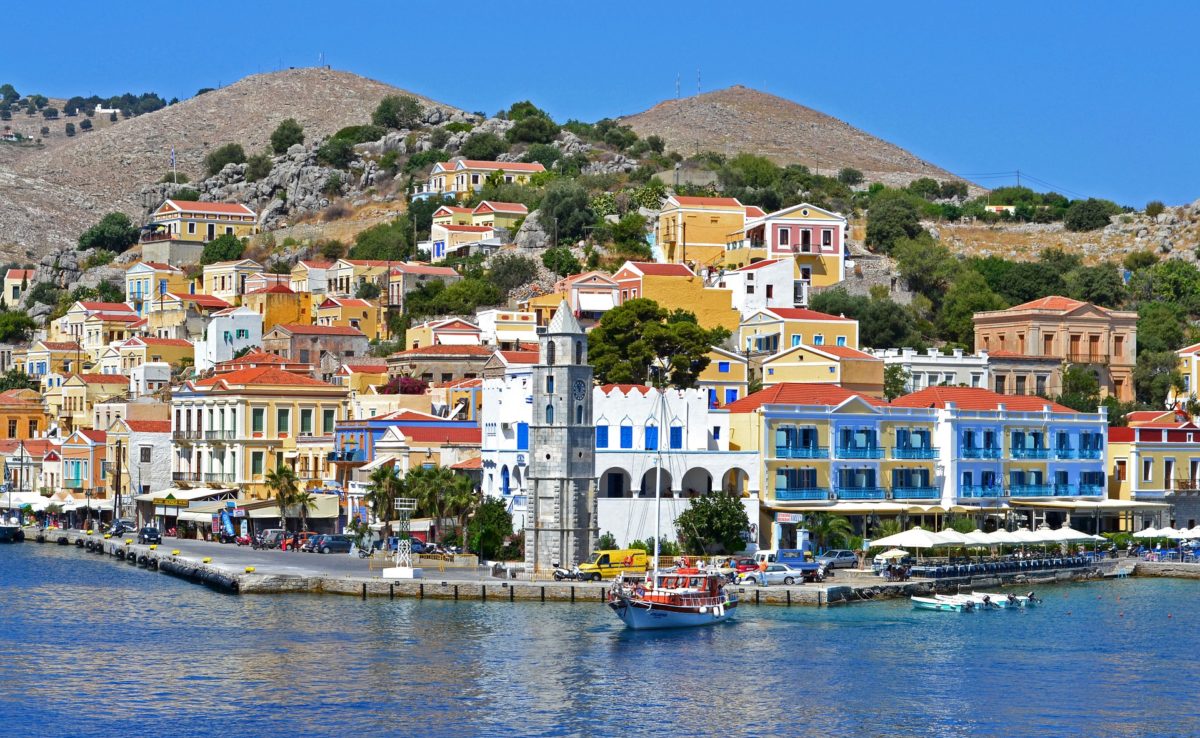MAP & INTRO
The Dodecanese islands have been inhabited since pre-Minoan times, and by the Archaic period, Rhodes and Kos had emerged as the dominant islands within the group. Distance from Athens gave the Dodecanese considerable autonomy and they were, for the most part, free to prosper unencumbered by subjugation to imperial Athens.
The Dodecanese islanders were the first Greeks to become Christians. This was through the tireless efforts of St Paul, who made two journeys to the archipelago, and through St John, who was banished to Patmos, where he had his revelation. By the early 14th century, it was the crusaders – the Knights of St John of Jerusalem, or Knights Hospitallers – who eventually became rulers of almost all the Dodecanese, building mighty fortifications,
After the Knights, the Turks ruled over the islands from 1522 until 1912. The Turks were ousted by the Italians in 1912 during a tussle over possession of Libya. The Italians, inspired by Mussolini’s vision of a vast Mediterranean empire constructed grandiose public buildings in the Fascist style, which was the antithesis of archetypal Greek architecture. More beneficially, they excavated and restored many archaeological monuments. The Dodecanese were formally returned to Greece in 1947.
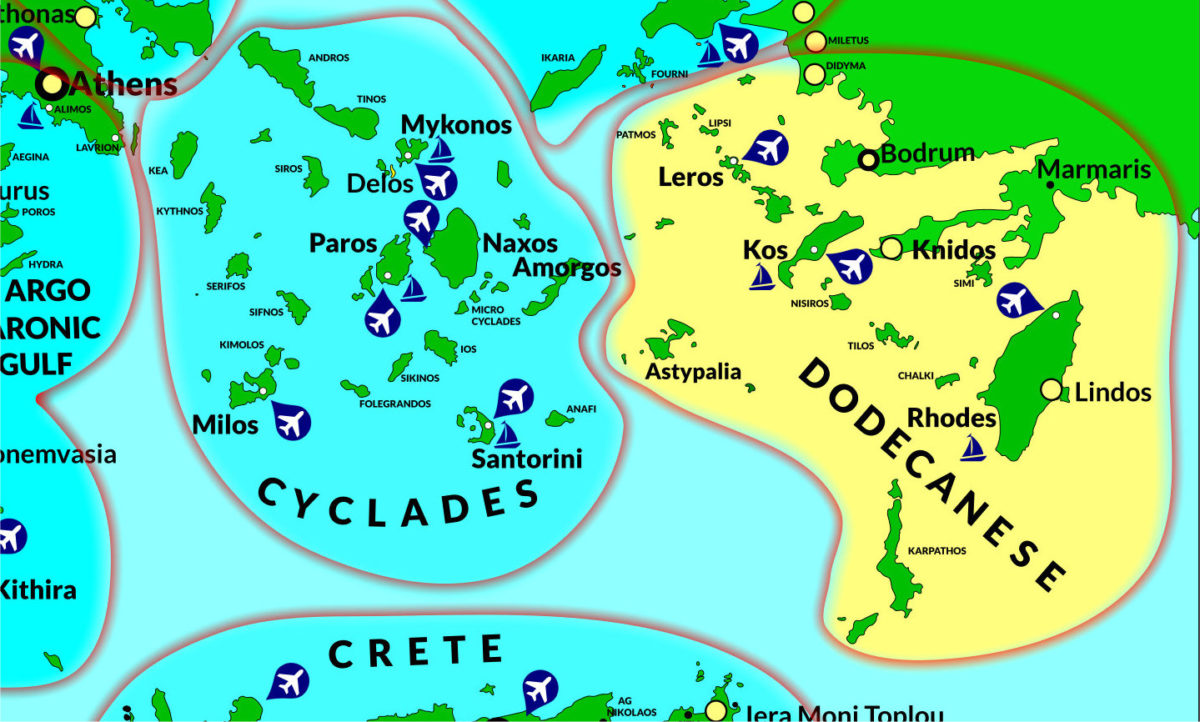
The Dodecanese is the sunniest corner in Greece. Twelve large islands and numerous smaller ones with crystal clear waters, sandy or pebbly beaches, important archaeological finds, imposing Byzantine and medieval monuments and unique traditional settlements are waiting to be discovered. Unsure where to start? In this section, we try to shed some light on the different islands and exploring the Dodecanese by sailboat, catamaran or motor yacht.
The beaches on the Dodecanese Islands are amongst the cleanest and most beautiful in Greece. Here you will enjoy unforgettable moments under the hot Aegean Sea summer sun. You will find some of the islands in the Dodecanese cosmopolitan and full of life, but at the same time, you can easily retreat to the quiet and peaceful places. Many of the islands have retained their traditional appearances, and provide many charming photo opportunities.
THE BEST WAY TO SAVOR THE DODECANESE
A yacht holiday provides access that can not be achieved in any other way — your floating hotel suite allows you to travel effortlessly and provides access to the finest islands, villages, beaches, and experiences.
With so much to see and visit, we recommend you allow at least two weeks to explore this paradise. If you want to sail for a week your first decision has to be where to start; Kos, Rhodes or maybe Samos (technically not part of the Dodecanese) and what area to explore, the southern or northern Dodecanese.
WHEN TO VISIT THE DODECANESE
In the summer the prevailing wind is the Meltemi that is blowing from the N-NW. It can blow strongly in July through to September but not as strong as in the Cyclades. In the summer months, it regularly blows Force 4-6 and may on occasion reach Force 7. Temperatures in the summer can reach 35 degrees Celsius.
If you want to sail early or late summer, the Dodecanese is a good choice as this sailing area is the most southern sailing area in Greece.
Sailing Routes or Itineraries for the Dodecanese
DESTINATIONS IN THE DODECANESE
When sailing the Dodecanese you have two choices to start from; Rhodes or Kos. The biggest selection of quality yachts can be found in Kos. Kos is situated in the center of the Dodecanese, Rhodes is situated in the South Side of the Dodecanese. If you want to sail for two weeks and explore most of the islands of the Dodecanese I would suggest starting in Rhodes.
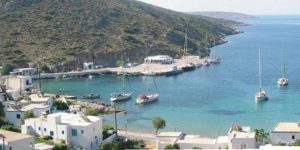
AGATHONISI
Agathonisi is the north most islet of the Dodecanese island complex with a quite impressive coastal configuration and many beautiful windless bays. The island of Agathonisi was named Yetousa in ancient times.
According to contemporary researches, today’s name is the result of an etymological mistake from the plant from which the name is derived ‘Agkathonisi’ ie. Island of the Thorns.
There is a small port with some wonderful tavernas. Ones moored safely you could stroll down to a small beach of Spilias at the entrance of the bay.
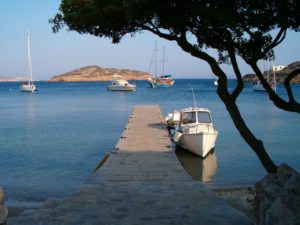
ARKOI, MARATHOS and MAKRONISI
Arkoi, Marathos and Makronisi are a group of tiny islands close to Patmos and Lipsi on the Southside of the Dodecanese.
Arki is one of the very few islands where 3/4 of the terrain is still uninhabited and untouched by people. On the island except for peace and quiet one can also reach many splendid places as well as beaches. Tiganakia is the most beautiful beach famous for its blue, crystal water
Marathos is one of those tiny (and I mean really tiny) islands that have it all for a sailboat. A beautiful beach, space for anchoring/mooring and a couple of tavernas on the beach that are worthwhile!
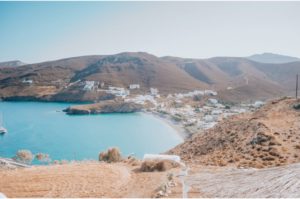
ASTYPALIA
Astypalea is arguably one of the most beautiful islands of the Dodecanese! This small, butterfly-like shaped island is yet to be discovered by mass tourism, thus it boasts a peaceful atmosphere.
It is a wonderful island to explore by boat, however, when you are planning to sail in July and August it could be unreachable because of the strong prevailing Meltemi winds.
Even though Astypalea belongs to the Dodecanese island group, it has a Cycladic architecture. The Venetian Castle on the top of a hill in Chora, traditional windmills and whitewashed houses create a magical setting that never fails to seduce visitors!
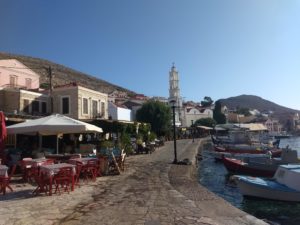
CHALKI, ALIMIA
Chalki is a beautiful island of the Dodecanese, located very close to Rhodes. Not much developed in tourism, this is a perfect destination for peace and privacy, although there are some daily tripper boats bringing in tourists from Rhodes.
With a yacht, you can visit Nimporio, the main port of the island or choose to stay in a bay just west of the port. In the port, you will find restaurants with local food, cafes and a few small shops.
The uninhabited utopic island of Alimia lies just east of Chalki. It consists of a big bay and some smaller bays that are perfect for an afternoon anchorage and possible an overnighter.
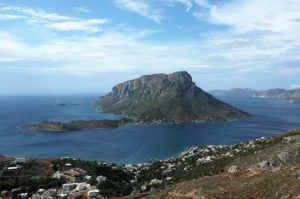
KALIMNOS, TELENDOS
Kalymnos is the third most populous island of the Dodecanese, after Kos and Rhodes. It is known in Greece for the affluence of much of its population, and also stands as both the wealthiest member of the Dodecanese and one of the wealthiest Greek islands overall.
Kalymnos is mostly mountainous with complicated topography. The coastline is very irregular, with many sheltered coves to drop an anchor. There are some springs, one among them being thermal. Kalymnos is a popular rock climbing and bouldering location with more than 1700 climbing routes set in the limestone rock of the island and a climate that allows climbing all year round.
Kalymnos is neighbored by the small island of Telendos, which was once part of Kalymnos, but split off after a major earthquake in 554 AD and is now separated from Kalymnos by a channel of water.
Telendos is approximately semi-circular in shape, consisting of a single, steep, flat-top mountain whose sides plunge directly into the sea. The only flat land is at the southern tip of the island, which is where the only settlement is located. There are no cars on the island
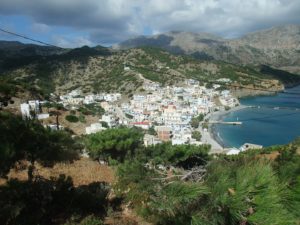
KARPATHOS, KASOS
Karpathos is the second largest of the Greek Dodecanese islands. The island of Karpathos was in both ancient and medieval times closely connected with Rhodes. Its current name is mentioned, with a slight shift of one letter, in Homer’s Iliad as Krapathos.
Tall mountains, pristine scenery, traditional villages, turquoise waters, and rich history makes this island an ideal destination to fill your holidays with joy. The inhabitants of Karpathos know how to grasp the joys of life during their local festivals and live up to their long-lasting traditions.
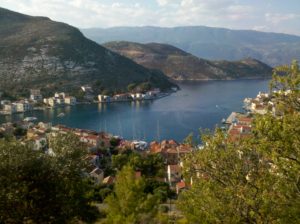
KASTELORIZO, STRONGYLI
Despite its small size Kastelorizo was once known as Megisti – meaning Great One. If you are looking for an off the beaten track island while sailing in Greece, Kastelorizo is number one. Its hard to reach though, the closest Greek island Rhodes is almost 70Nm away.
The island has become more popular in recent years among tourists looking for an isolated place in the Dodecanese, thanks also to the 1991 Oscar-winning movie Mediterraneo, by Gabriele Salvatores, which is set on the island during the Second World War.
Strongyli is the easternmost Greek territory and is inhabited.
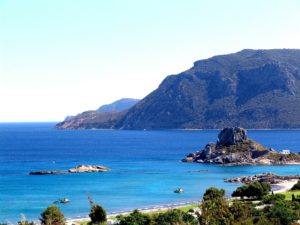
KOS
Kos island is the third-largest island of the Dodecanese and is just four miles away from the Turkish coast. Geographically located between Kalymnos and Nisyros, Kos has a rich history, influenced by many cultures. Therefore, sightseeing in Kos is more than enjoyable! Asklepion, the holistic medical center of Hippocrates, Neratzia medieval Castle and Antimachia Castle are some of the best historical monuments to visit!
Visitors to Kos naturally tend to focus their attention on its beaches. Beyond those near Kos Town, there are three main resort areas. Kardamena, on the south coast, is very much dominated by package tourism, but Mastihari, on the north coast, and Kamari, in the far southwest, are more appealing and less busy.
If you only have one night in town take a stroll around town as it is a sight to behold including mosques, Italian-era buildings, ancient structures, narrow alleys, the marina with the yachts, and the palm-tree boulevard with street artists.
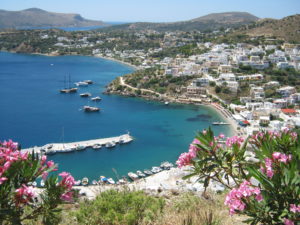
LEROS
Leros is known for its imposing medieval castle of the Knights of Saint John possibly built on a Byzantine fortress. The capital of Leros is the city of Platanos that in recent years has been connected with Agia Marina in the north and Panteli to the south on both sides of the slopes of Apitiki hill where is the Castle of Virgin Mary.
The architecture at Lakki is another reason to dock on this island. The area around Lakki was built up as the main base of the Italian Royal Navy in the Dodecanese starting in 1923. After the Naval base, the town of Portolago was founded in the 1930s, under Italian rule, as a new model town for Mussolini. Eventually, the town name was changed to Lakki.
Leros is green, has an excellent road network and is one of the few Greek islands, which is alive during summer and winter.
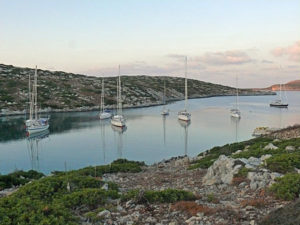
LEVITHA, KINAROS
Levitha known in classical antiquity as Lebinthus or Lebinthos is a small Greek island located in the east of the Aegean Sea, between Kinaros and Kalymnos, part of the Dodecanese islands. It’s an almost uninhabited island except for one family. Its nearest neighbor is Kinaros.
During the summer months, both islands are frequented by fishing boats and sailing yachts that take advantage of their protected coves. It is very attractive and out of the way place, ideal for stopping between Patmos and Astypalea.
The inhabitants are all members of the Kamposos family (Demetris, Irene and their sons Tasos and Manolis). They live on a neat hamlet and raise animals. In the summer they also ran a small but very attractive and spotless restaurant for the visiting yachts. They grill to perfection fresh fish and meat.
The island has many goat paths and one can take very pleasant long walks. On top of the island there is an abandoned World War II Italian outpost.
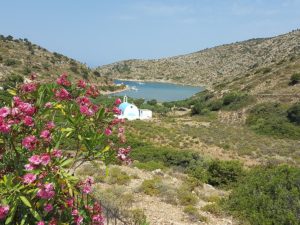
LIPSI and Archipelago
Lipsi island is a simple and authentic greek island with the right balance between past and present. It has an area of 16 square km and 36 km of coastline, therefore is extremely easy to know even on foot. Trekking, or simple walks, is very popular among tourists who spend their holidays in Lipsi. Lipsi is the only island of the archipelago to be inhabited while all the others, such as the beautiful Aspronisi, Kalapodia, Franco, Plavi and another twenty or so islands, are extremely small and uninhabited, ideal for a boat trip.
Three from the town is located the most beautiful beach on the island called Plati Gialos. This wonderful bay of Lipsi is undoubtedly the best known and most visited; the mere sight of this beach of white sand, and of its turquoise sea, takes your breath away.
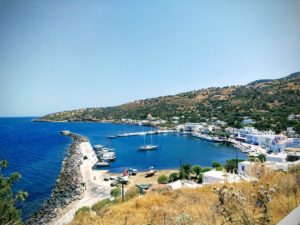
NISYROS, GYALI
Nisyros is one of the Aegean islands, still untouched by mass tourism. It is part of the Dodecanese group of islands, situated between Kos and Tilos. The island extends over a surface of 41 km and its coastline is 28 km long. It can be reached by ferry from Piraeus, Kos, and Rhodes.
According to mythology, it was created during the war between Gods and Giants. Poseidon chased the Giant Polyvotis down to Kos, cut a part of it and threw it to his enemy, sinking him forever in the bottom of the Aegean Sea. The legendary rock is the modern Nisyros and it is said that the volcano’s explosions are the angry breathing of the defeated Giant.
These explosions shaped the island, which is considered to be the youngest volcanic center in Greece. The volcano is still active – along with the volcanoes of Milos, Santorini, and Methana.
During antiquity, the island thrived on obsidian commerce, extracted by the inhabitants of Nisyros, from the nearby island, Gyali.
Gyali also is written as Yiali is a small volcanic island located halfway between the south coast of Kos (Kardamaina) and 2 n.m NW from Nisyros Island. Its SW part consists of thick layers of pumice-stone, while its NE part consists of obsidian currents and perlite.
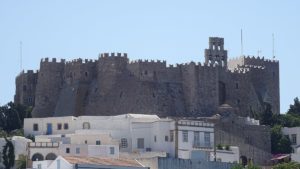
PATHMOS
Worldwide known as a sacred island for it is the place where Saint John wrote the Book of Revelation, Patmos is an ideal destination for nature lovers thanks to its lace-like coastline, sheer cliffs, and volcanic soil.
Patmos is a significant Christian pilgrimage site. Its Cave of the Apocalypse is where John of Patmos (St. John the Theologian) is said to have written the Book of Revelations. A fortresslike, 11th-century monastery dedicated to the saint overlooks the whitewashed houses of the hilltop capital, Hora (also known as Chora).
Due to its spiritual character, the island plays host to many religious festivals and feasts, which are a perfect opportunity for travelers to introduce themselves to the tradition and history of Patmos.
Patmos is a great island to relax and get away from daily routine. The most organized beaches in Patmos are Skala, Agriolivado and Livadi Geranou. There are also many Patmos beaches with fewer facilities but they are extremely impressive and rich in natural beauty. The majority of Patmos beaches can be accessed by foot from Skala.
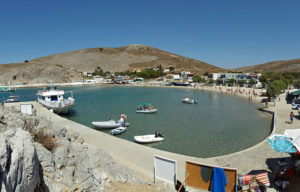
PSERIMOS
Pserimos also is known as Kapari, (capers grow in abundance here), Pserimos is the tiny island (less than 15 square km) that lies just four a few kilometers north of Kos. With around 100 permanent residents and the simple pleasures of a Greek isle off-the-beaten-track, it makes a great day out.
The island has beautiful beaches and is, therefore, a popular destination for day-trippers coming from Kos trying to escape the crowds. There are no cars or roads on Pserimos, making it peaceful and quiet and an excellent island for making walks. In the harbor are a number of taverns which ensure that the visitors lack nothing
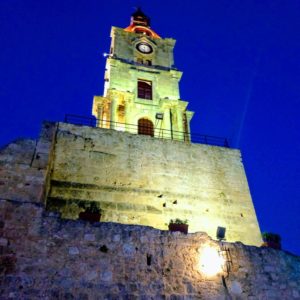
RHODES
Being the largest and most popular Greek islands of the Dodecanese group, Rhodes Greece is a top holiday destination! Its a great starting point for your sailing holiday in the Dodecanese.
Also known as the “Knights’ island”, Rhodes has a rich historical past, which you can tell by its historical buildings and monuments. The atmosphere in Rhodes Old Town is simply unique! Strong walls, stone-paved alleys, elegant mansions, and a medieval castle create the illusion that you have time-traveled back to the age of the knights. Don’t be surprised if you believe you’re into a medieval fairytale. Who knows? Maybe you were a knight or a princess in your past life!
As for the things to do in Rhodes, you’ll never run out of options! Stroll around the historical Rhodes town, visit the medieval monuments of Rhodes Old Town, discover imposing castles, eat at excellent restaurants and swim at the amazing Rhodes beaches.
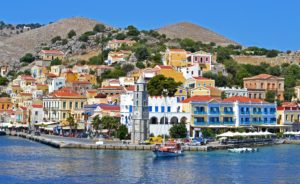
SIMI
Symi island Greece is one of the gems of the Dodecanese island chain! It stands out of the other Greek islands for its beautiful architecture, colorful houses, and a relaxed atmosphere. The port of Symi seems to have popped out of a painting! The first thing that catches your eye as you approach Symi by ferry is the colorful mansions around the port. The setting oozes charm in abundance! The port of Symi is hands down the ultimate spot for romantic walks and sunset gazing!
Beaches in Simi are actually small coves but attract many visitors for their picturesque environment. Some Simi beaches are organized with tourist facilities, like taverns, bars, umbrellas, and sunbeds like Nos, Emporios, and Pedi. The rest of Simi beaches are secluded and ideal for privacy. The best way to explore the beaches is by boat.
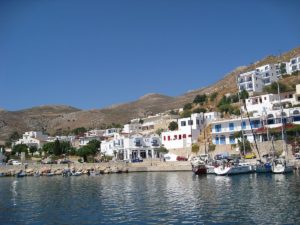
TILOS
Tilos is one of the Greek islands that belong to the Dodecanese chain. Still untouched by mass tourism, Tilos island keeps its unspoiled charm. Thanks to its secluded location and raw natural ambiance, Tilos has emerged as an alternative destination for holidays in Greece.
Livadia, the island’s port, is the most touristic place in Tilos. Mikro Chorio, though, is the most interesting one! Mikro Chorio is a ghost village, which is abandoned, oozing a unique mysterious charm. Don’t give it a miss!
After exploring the villages of Tilos Greece, you should head to the beach. Quite frankly, there’s luscious swimming to be had on Tilos beaches! As you’d expect from an unspoiled island, Tilos beaches are secluded and unorganized, ideal for those who seek privacy. Some of them are naturist beaches and can be easily accessed either on foot or by the small local bus.
Greek Island yacht holidays provide the best access to the islands of the Dodecanese.
You’ll be surprised at how reasonable your private floating hotel suite (yacht with captain and cook/host) is.
Contact us now for a quotation on your magic Cyclades yacht holiday.

SAIL AND STAY
Some of our clients like to extend their Yacht Holiday by staying a few days before or after their cruise in Kos, Rhodes or on one of the islands.
A few days in Kos or Rhodes can be a great holiday starter, and if your group is flying in from different or distant countries this allows you time to catch up and recover from jet lag before your cruise. If you’re interested in history and art you may enjoy a visit to the
We are happy to recommend great places to stay, dine, explore and shop and can book your hotels and arrange airport and port transfers for you.
If you plan to spend some days on one of the islands, here is a brief overview of tourist numbers you can expect to encounter.
TOURISM IN THE DODECANESE
The Dodecanese have been popular with visitors for centuries and they are a perfect choice for a sailing and island holiday in Greece.

ANTIQUITIES
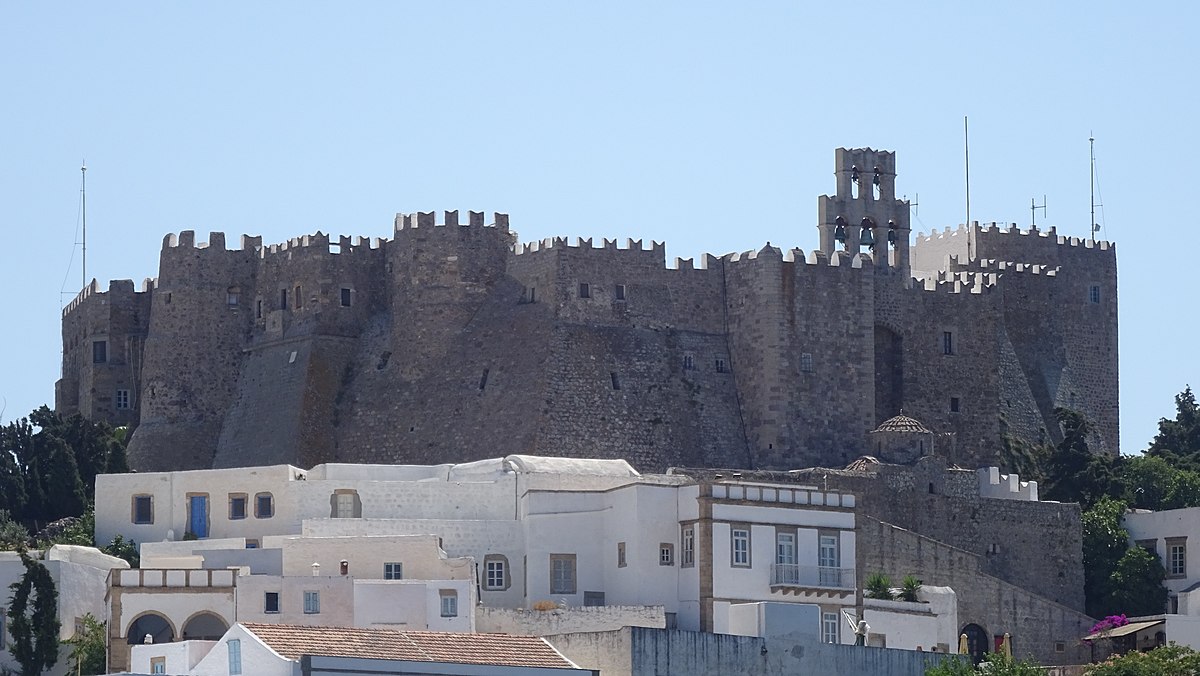
The Dodecanese have been inhabited since prehistoric times. In the Neopalatial period on Crete, the islands were heavily Minoanized (contact beginning in the second millennium BC). Following the downfall of the Minoans, the islands were ruled by the Mycenaean Greeks from circa 1400 BC, until the arrival of the Dorians circa 1100 BC. It is in the Dorian period that they began to prosper as an independent entity, developing a thriving economy and culture through the following centuries. By the early Archaic period, Rhodes and Kos emerged as the major islands in the group, and in the 6th century BC, the Dorians founded three major cities on Rhodes (Lindos, Kameiros, and Ialyssos). Together with the island of Kos and the cities of Knidos and Halicarnassos on the mainland of Asia Minor, these made up the Dorian Hexapolis.
This development was interrupted around 499 BC by the Persian Wars, during which the islands were captured by the Persians for a brief period. Following the defeat of the Persians by the Athenians in 478 BC, the cities joined the Athenian-dominated Delian League. When the Peloponnesian War broke out in 431 BC, they remained largely neutral although they were still members of the League.
The Peloponnesian War had weakened the entire Greek civilization’s military strength that it lay open to invasion. In 357 BC, the islands were conquered by the king Mausolus of Caria, then in 340 BC by the Persians. But this second period of Persian rule proved to be nearly as short as the first, and the islands became part of the rapidly growing Macedonian Empire as Alexander the Great swept through and defeated the Persians in 332 BC, to the great relief of the islands’ inhabitants.
Following the death of Alexander, the islands, and even Rhodes itself, were split up among the many generals who contended to succeed him. The islands formed strong commercial ties with the Ptolemies in Egypt, and together they formed the Rhodo-Egyptian alliance which controlled trade throughout the Aegean in the 3rd century BC.
In 164 BC, Rhodes signed a treaty with Rome, and the islands became aligned to a greater or lesser extent with the Roman Republic while mostly maintaining their autonomy. Rhodes quickly became a major schooling center for Roman noble families, and, as the islands (and particularly Rhodes) were important allies of Rome, they enjoyed numerous privileges and generally friendly relations. These were eventually lost in 42 BC, in the turmoil following the assassination of Julius Caesar in 44 BC, after which Cassius invaded and sacked the islands.
In the 1st century, Saint Paul visited the islands twice, and Saint John visited numerous times; they succeeded in converting the islands to Christianity, placing them among the first dominantly Christian regions. Saint John eventually came to reside among them, being exiled to Patmos, where he wrote his famous Revelation.
During the Byzantine years, the inhabitants of the Dodecanese followed Christianity. In the centuries that followed, they suffered a lot from the Persians, Arabs, Venetians, Genouates, and Ottomans. Under these circumstances, the inhabitants were forced to abandon their houses and retreat to the mountainous regions. After the first Crusades and the indulgence of the privileges from the Pope, the order of Knights of Saint John started was developed as a strong military and political power. In 1312 AC the order of Knights occupies Rhodes and the rest of its neighboring islands. Rhodes was greatly influenced by the western culture and its port became one of the most important trading centers in the Dodecanese. During that long period, Rhodes shined in art, sculpture, architecture, and letters. The order of Knights fortified the whole town of Rhodes with strong walls to protect the Aegean from the Turkish invasions.
In 1523, with the arrival of sultan Souleiman, Dodecanese is no longer under the rule of the Knights but under the Ottoman occupation. This is one of the darkest periods in the Dodecanese characterized by terror and destruction. The churches are turned into mosques and personal belongings are damaged. Above all, their act of participation in the Greek revolution was greatly punished with slaughters and holocausts.
In 1912, the Ottomans sold the Dodecanese islands to the Italians and a new period of occupation starts. Although the Italians made many public works, including ports, official buildings, and even restored the Medieval Town of Rhodes, the locals were always fighting for their independence. Finally, in 1947 with the Treaty of Paris, the Dodecanese islands became officially part of Greece.
PLACES TO VISIT
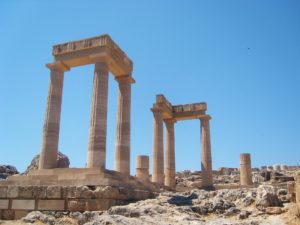
ACROPOLIS OF LINDOS ON RHODES
Lindos was founded by the Dorians led by the king Tlepolemus of Rhodes, who arrived in about the 10th century BC. It was one of six Dorian cities in the area known as the Dorian Hexapolis. The eastern location of Rhodes made it a natural meeting place between the Greeks and the Phoenicians, and by the 8th century, Lindos was a major trading center.
In the 6th century, it was ruled by Cleobulus, one of the Seven Sages of Greece. The importance of Lindos declined after the foundation of the city of Rhodes in the late 5th century BC.
In classical times the acropolis of Lindos was dominated by the massive temple of Athena Lindia, which attained its final form in around 300 BC. In Hellenistic and Roman times the temple precinct grew as more buildings were added. In early medieval times, these buildings fell into disuse, and in the 14th century, they were partly overlaid by a massive fortress built on the acropolis by the Knights of St John to defend the island against the Ottomans.

MONASTERY OF ST. JOHN AND OF THE APACOLYPSE PATMOS
The Historic Centre (Chorá) with the Monastery of Saint-John the Theologian and the Cave of the Apocalypse on the Island of Pátmos.
The island of Pátmos in the Dodecanese is reputed to be where St John the Theologian wrote both his Gospel and the Apocalypse. A monastery dedicated to the ‘beloved disciple’ was founded there in the late 10th century and it has been a place of pilgrimage and Greek Orthodox learning ever since. The fine monastic complex dominates the island. The old settlement of Chorá, associated with it, contains many religious and secular buildings.
The Monastery of St. John the Theologian on Patmos, is possibly the most important monastery of the Aegean Sea. It was founded by the Blessed Christodoulos (1088) who was granted the island of Patmos exempt from taxation by an imperial chrysobull of Alexius I Comnenus.
Built on a mound, on the site formerly occupied first by a temple dedicated to the goddess Artemis (Diana) and then by an Early Christian basilica, the Monastery is surrounded by an irregular fortified quadrangle whose successive building phases span the period from the late 11th century to the 17th century.
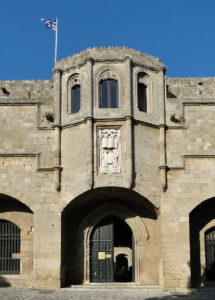
ARCHAEOLOGICAL MUSEUM OF RHODES
The Archaeological Museum of Rhodes is located in the Medieval City of Rhodes. The museum is housed in the monumental edifice that was the hospital of the Knights of Saint John. Construction of it was begun in 1440 and brought to completion in the time of the Grand Master d’Aubusson (1476-1503).
The Museum contains various collections of archaeological artifacts from various parts of Rhodes and the neighboring islands, including the Statue of the Crouching Aphrodite (1st century BC), which was inspired by a famous prototype work created by the sculptor Doidalsas in the 3rd century BC, and the Pyxis of the Fikellura type (mid-6th century BC).
The museum also holds the Head of Helios, which was featured in 2011 on the album cover of Floral Shoppe by Macintosh Plus, and subsequently became famous for its association with the Vaporwave movement.
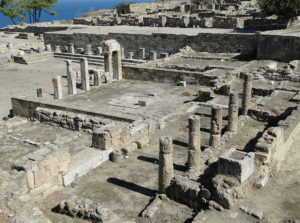
ANCIENT KAMIROS ON RHODES
On the north-western shore of Rhodes, close To the promontory of Agios Minas (the Ancient Mylantio) lies the third of The island’s ancient cities – Kamiros.
The ancient city was built on three levels. At the top of the hill was the acropolis, with the temple complex of Athena Kameiras and the stoa. A covered reservoir having a capacity of 600 cubic meters of water—enough for up to 400 families—was constructed about the sixth century BC. Later, the stoa was built over the reservoir. The stoa consisted of two rows of Doric columns with rooms for shops or lodgings in the rear.
The main settlement was on the middle terrace, consisting of a grid of parallel streets and residential blocks. On the lower terrace are found a Doric temple, probably to Apollo; the Fountain House, with the Agora in front of it; and Peribolos of the Altars, which contained dedications to various deities.
During the prehistoric period, the area was inhabited by the Mycenaean Greeks. The city itself was founded by the Dorians. The temple foundations were begun at least as early as the eighth century BC. The earthquake of 226 BC destroyed the city and the temple. The earthquake of 142 AD destroyed the city for the second time.[1]
The Acropolis was excavated by Alfred Biliotti and Auguste Salzmann between 1852 and 1864. Many of the finds from their digs are now kept in the British Museum in London.[2] In 1928 the Italian Archaeological School began a systematic excavation of the area together with restoration work which continued until the end of the Second World War.
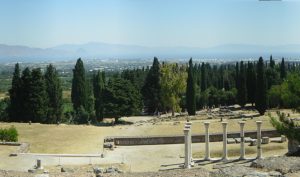
ASKLEPIEION ON KOS
Asclepeions were healing temples located in ancient Greece (and in the wider Hellenistic and Roman world), dedicated to Asclepius, the first doctor-demigod in Greek mythology. Asclepius was said to have been such a skilled doctor that he could even raise people from the dead. So stemming from the myth of his great healing powers, pilgrims would flock to temples built in his honor in order to seek spiritual and physical healing.
Asclepeions also became home to future physicians as well. Hippocrates is said to have received his medical training at an asclepeion on the isle of Kos. Prior to becoming the personal physician to the Roman Emperor Marcus Aurelius, Galen treated and studied at the famed asclepeion at Pergamon.
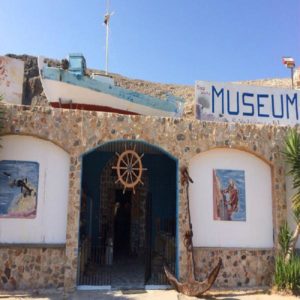
ST. VALSAMIDIS ON KALYMNOS
It is located in the coastal village of Vlichadia. It is a private museum, a life’s work of Valsamidis brothers, who were born and live in Kalymnos, with exhibits related to sponge fishing, a big variety of sea plants and sea animals and a collection of trade amphorae and other finds from ancient shipwrecks.Β
It is one of the richest private collections in Greece and they needed over forty (40) years to collect these findings. Various kinds of sponges, corals, shells, fish, strange sea creatures, sponge diving equipment, World War II findings, pictures, documents, coins, ancient amphora, and even an ancient wreck, are included in their collection.
Part of the museum is dedicated to the profession of sponge-fishing and includes all the tools and protective suits used by divers, from 1872 until today. In a wing are exhibited findings of the First and Second World War such as torpedoes, pieces of airplanes, etc. In a specially designed area, the visitor has the opportunity to see amphorae of the 6th, 4th, 3rd, and 2nd c.BC. There is also a collection of about 2,000 photographs related to the history and tradition of sponge-fishing.
Finally, in the museum you will also witness the sponge processing and you may find nice souvenirs such as sponges, corals, and shells in the store that operates within.
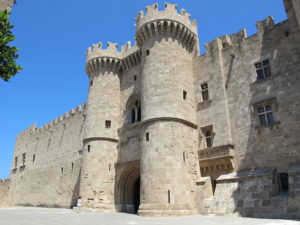
KNIGHTS QUARTER AND PALACE OF THE GRAND MASTER
The Palace of the Grand Master of the Knights of Rhodes, also known as the Kastello, from Italian: Castello, “castle”, is a medieval castle in the city of Rhodes, on the island of Rhodes in Greece. It is one of the few examples of Gothic architecture in Greece. The site was previously a citadel of the Knights Hospitaller that functioned as a palace, headquarters, and fortress.
According to a recent study, in the exact spot in which the palace exists today, there were the foundations of the ancient temple of the Sun-god ‘Helios’ and probably that was the spot where Colossus of Rhodes stood in the Antiquity.
The palace was originally built in the late 7th century as a Byzantine citadel. After the Knights Hospitaller occupied Rhodes and some other Greek islands (such as Kalymnos and Kastellorizo) in 1309, they converted the fortress into their administrative center and the palace of their Grand Master.
In the first quarter of the 14th century, they repaired the palace and made a number of major modifications. The palace was damaged in the earthquake of 1481, and it was repaired soon afterward.
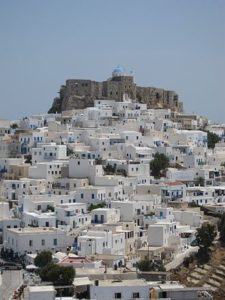
ASTYPALAIA CASTLE
The scenic hilltop Venetian castle in the island’s Hora is certainly worth the climb – although little remains of the castle itself, views that uncover from here are simply spectacular, with an avalanche of whitewashed houses leading down to the cerulean waters of the Aegean.


